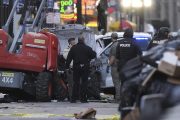
A four-minute instructional video just released by the Department of Homeland Security (DHS) entitled “Active Shooter Situation: Options for Consideration” is filled with numerous suggestions for people confronting an “active shooter,” including evacuating the area, hiding from the shooter, warning others about the danger, locking and blocking doors, and silencing cellphones. Only in the gravest extreme, however, is resistance recommended:
If you are caught out in the open and cannot conceal yourself or take cover, you might consider trying to overpower the shooter with whatever means are available.
As the narrator is intoning this, the video shows an office worker reaching into his drawer and pulling out… a pair of scissors.
The video was in production long before the shooting incident in Newtown, Connecticut, and is based on the DHS’s 2008 training manual, Active Shooter — How to Respond, which defines an “active shooter” as “an individual actively engaged in killing or attempting to kill people in a confined and populated area.”
The manual warns that “because active shooter situations are often over within 10 to 15 minutes … individuals must be prepared both mentally and physically to deal with an active shooter situation.”
It provides “good practices for coping” with such an event, including being aware of the surrounding environment, noting the nearest exits, shutting and locking the door to the office, and “as a last resort, attempt[ing] to take the active shooter down. When the shooter is at close range and you cannot flee, your chance of survival is much greater if you try to incapacitate him/her.”
Ron Borsch, a 30-year law-enforcement veteran who manages the South East Area Law Enforcement (SEALE) Regional Training Academy in Bedford, Ohio, has analyzed more than 90 “active shooter” incidents that have taken place in schools, shopping malls, churches and workplaces, and he knows those shooters well: They generally act alone, they usually have more than one weapon, they seek unarmed “soft targets,” they strike without warning, they do not take hostages, and they do not negotiate. But Borsch also notes that they “typically fold quickly upon armed confrontation.” When met with resistance, 90 percent of them commit suicide on site. Borsch explains,
They choose unarmed, defenseless innocents for a reason: They have no wish to encounter someone who can hurt them. They are personally risk- and pain-avoidant. The tracking history of these murderers has proved them to be unlikely to be aggressive with police. If pressed, they are more likely to kill themselves.
He recommends the “swift application of deadly force over seeking defensive cover in most instances,” directly contradicting the advice given in the DHS video: “An unintentional consequence of going to cover may be to lose sight of the offender, allowing him to gain the momentum of battle and shoot more innocents until [the incident is] over.”
The DHS video conveniently ignores incidents that were neutralized or terminated with little or no consequence by the use of force wielded by armed citizens. For instance, there is the 1991 incident at a Shoney’s Restaurant in Anniston, Alabama, that could have been mentioned. Late at night on December 17, 1991, two armed thugs entered the restaurant, rounded up all of the customers and employees and locked them into a walk-in refrigerator. All but one, that is. Thomas Glenn Terry avoided the roundup and hid under a table. He was legally armed with a .45 ACP semi-automatic pistol, and when one of the thugs discovered him, Terry emptied five rounds into his chest, killing him instantly. When the other thug fired on Terry, he returned fire, wounding him critically. The incident was over, and 20 lives were saved.
Or the video could have mentioned the Pearl High School shooting in 1997, in Mississippi, where 16-year-old Luke Woodham went “active,” shooting and wounding or killing several innocents before being neutralized by the school’s principal, Joel Myrick, who wielded his legally carried .45 ACP semi-automatic pistol.
Or the video could have mentioned the New Life Church shooting, which occurred in Colorado Springs in 2007, when Matthew Murray entered the 5,000-member church during Sunday morning service and began to shoot people. When Murray was confronted by an armed member of the congregation, Jeanne Assam, he took his own life, ending the spree.
In his 1980 book, In the Gravest Extreme, Massad Ayoob, an internationally known firearms instructor, agreed with Borsch in that an armed confrontation of an “active shooter” is likely to end the incident instantly. Wrote Ayoob:
Despite all the junk “rape defense manuals” and similar pop lit [like the DHS video], there’s only one way you can talk a violent criminal out of harming you once he’s picked you as a victim. What you have to do is hit him with a deep, existential question, something that will make him re-examine and re-evaluate his own personal values and life style, his own hopes and dreams, as related to the moment at hand.
It can even be phrased without words.
https://www.youtube.com/watch?v=oI5EoWBRYmo
A graduate of Cornell University and a former investment advisor, Bob is a regular contributor to The New American and blogs frequently at www.LightFromTheRight.com, primarily on economics and politics. He can be reached at [email protected].



